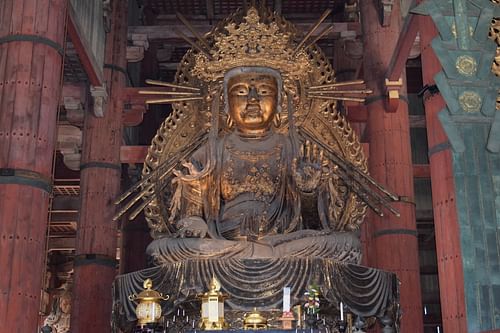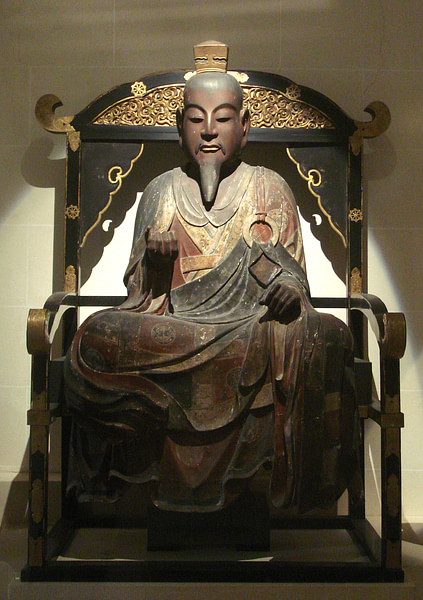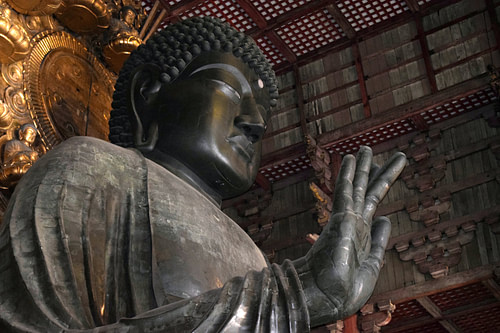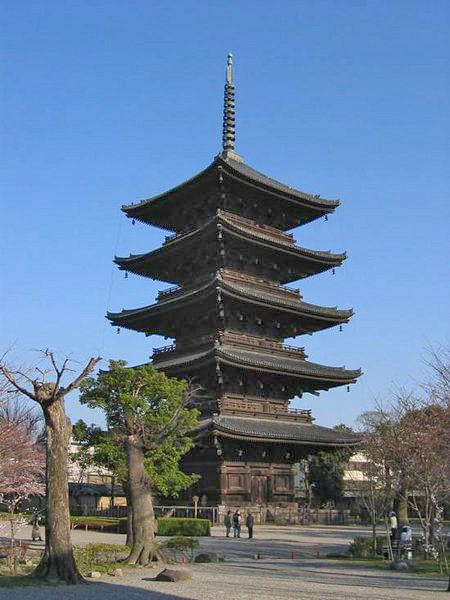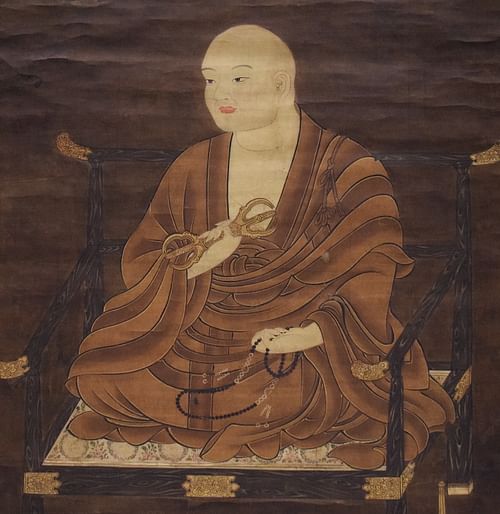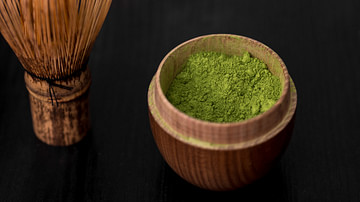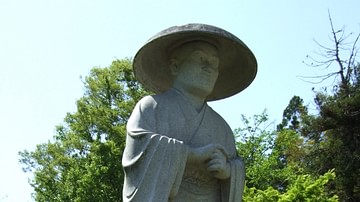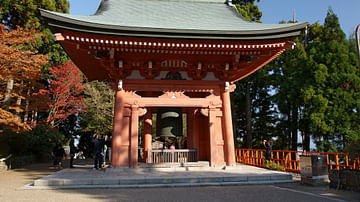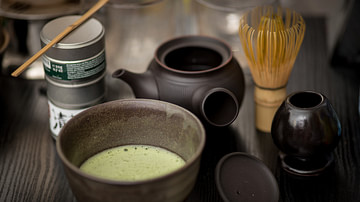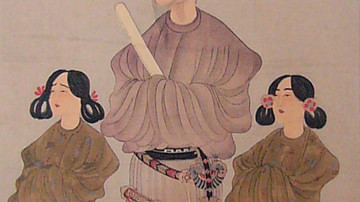Buddhism was introduced to ancient Japan via Korea in the 6th century CE with various sects following in subsequent centuries via China. It was readily accepted by both the elite and ordinary populace because it confirmed the political and economic status quo, offered a welcoming reassurance to the mystery of the afterlife, and complemented existing Shinto beliefs. Buddhist monasteries were established across the country, and they became powerful political players in their own right. Buddhism was also a key driver in fostering literacy, education in general, and the arts in ancient Japan.
Introduction to Japan
Buddhism was introduced into Japan in either 538 CE or 552 CE (traditional date) from the Korean kingdom of Baekje (Paekche). It was adopted by the Soga clan particularly, which had Korean roots and was practised by the significant Korean immigrant population in Japan at that time. Buddhism received official government support in 587 CE during the reign of Emperor Yomei (585-587 CE), even if some aristocratic clan groups (the Monobe and Nakatomi especially) opposed it and still adhered to purely Shinto beliefs. Buddhism reinforced the idea of a layered society with different levels of social status with the emperor very much at the top and protected by the Four Guardian Kings of Buddhist law. The aristocracy could also handily claim that they enjoyed their privileged position in society because they had accumulated merit in a previous life.
In addition to the reinforcement, Buddhism gave to the status quo; the adoption of Buddhism, it was hoped, would be looked on favourably by the more advanced neighbouring cultures of Korea and China and enhance Japan's reputation as a rising civilised nation in East Asia. Once officially adopted, monks, scholars, and students were regularly sent to China to learn the tenets of Buddhism in more depth and bring back that knowledge, along with art and even sometimes relics, for the benefit of the Japanese people.
Prince Shotoku & the Spread of Buddhism
The man credited with really putting Buddhism at the forefront of Japanese religious practices is Prince Shotoku (574-622 CE), who ruled Japan as regent from 594 CE until his death. Shotoku famously drew up a new constitution (or, perhaps more accurately, an ethical code) in 604 CE called the Seventeen Article Constitution (Jushichijo-kenpo). The points made therein attempted to justify the centralisation of government and emphasised both Buddhist and Confucian principles, especially the importance of harmony (wa). Shotoku particularly emphasised the reverence of Buddhism, as seen in Article II of his constitution:
Sincerely reverence the three treasures. The three treasures, Buddha, the Law and the Priesthood, are the final refuge of the four generated beings, and are the supreme objects of faith in all countries. What man in what age can fail to reverence this law? Few men are utterly bad. They may be taught to follow it. But if they do not betake them to the three treasures, how shall their crookedness be made straight? (Henshall, 499)
True to his own declaration, Shotoku built many temples and monasteries, formed a body of artists to create Buddhist images, and he was himself a student of its teachings, writing commentaries on three sutras. During his reign, Shotoku built 46 Buddhist monasteries and temples, the most important of which were the Shitennoji, Hokoji (596 CE), and Horyuji.
Imperial Favour
The spread continued with the full support of Emperor Temmu (r. 672-686 CE) and Empress Jito (r. 686-697 CE) who built yet more temples, had more copies of sutras made, and who used monasteries as depots for official population and tax records. Emperor Shomu (r. 724-749 CE) was even more ambitious and set out to build a temple in every province, each with its own seven-storied pagoda, a plan that raised taxation to brutal levels. Major temples were built at the then capital Nara, too, such as Todaiji, finally completed in 752 CE in a project supervised by the celebrated monk Gyogi (668-749 CE). Emperor Shomu was also important as he began the strategy of an emperor abdicating in favour of his chosen successor and then joining a monastery but still pulling political strings behind the latticed screens in what became known as 'cloistered government'.
At the same time as endorsing Buddhism, the Japanese elite was also wary of its powers and particularly concerned that a charismatic individual might abuse the reverence of the populace and form a following which could threaten the political stability of the state. For this reason, a body of laws was passed in the 8th century CE (the Taiho ritsuryo in 702 CE and Yoro ritsuryo in 757 CE) which forbade monks to have private chapels, practise divination, make any attempt to actively convert believers of one faith to another, and use magic to cure illness. Neither could monks or nuns accept gifts of slaves, cattle, or weapons, own land, buildings or valuables in their own name, trade, collect interest on loans, or even become a monk after the required period of study without official permission.
In another precaution, Buddhist monasteries and monks were carefully monitored and their actions subject to the laws which applied to all citizens, even if their punishments were usually a little more lenient. These measures did not actually achieve their aim as there are many instances of monks and temples abusing their position, illegally acquiring land, committing fraud, practising exorbitant usury (which often rendered the peasantry unable to pay their taxes), and making a healthy living as pawnbrokers charging 180% per annum.
Co-existence with Shinto
The indigenous beliefs of the ancient Japanese included animism and Shinto and neither were particularly challenged by the arrival of Buddhism. Shinto, especially, with its emphasis on the here and now and this life, left a significant gap regarding what happens after death and here Buddhism was able to complete the religious picture for most people. As a consequence, both religions co-existed, many people practised both, and even temples of both faiths existed together on the same site. Many Buddhist deities and figures from Indian mythology were readily incorporated into the already vast Shinto pantheon. At the same time Shinto gods acquired Buddhist names (Ryobu Shinto) so that, for example, the sun goddess Amaterasu was considered an avatar of Dainichi; and Hachiman, the god of war and culture, was the avatar of the Amida Buddha.
Even artworks of one religion appeared in the buildings of the other and priests frequently administered the temples or shrines of their counterpart religion. An imperial edict in 764 CE did officially place Buddhism above Shinto, but for the majority of the ordinary population, the opposite was probably true. One area where Buddhism almost completely replaced older beliefs was in death rituals as the Buddhist practice of cremation was widely adopted by all levels of society.
Buddhism & Wider Society
Buddhist monasteries were frequently given free land and an exemption from tax by emperors eager to have a blessing on their reign, and this resulted in them becoming both economically powerful and politically influential. Monasteries were able to pay for their own armed attendants, a necessary precaution in turbulent times when warlords and bandits frequently caused havoc far from the imperial capital and, more importantly, a useful source of muscle to bend local officials to their way of thinking. The monasteries became so powerful that Emperor Kammu (r. 781-806 CE) had even moved the capital from Nara in 784 CE to get away from the Buddhist temples around the city. This did not stop the monasteries, especially Kofukuji, Todaiji, Enryakuji, and Onjoji from using force many times throughout the 10th and 11th centuries CE to expand their domains and gain favourable conditions from local governors and administrators. Rivalries, inevitably, grew up between monasteries, notably between To-ji and Kyosan.
On a more peaceful note, monasteries were an important part of the local community, providing schools and facilities for higher studies, libraries, and food and shelter to the needy. Monks also helped in communal projects such as road, bridge, and irrigation building - even if this sometimes irked the imperial court when the monks received large donations from a grateful public and caused some emperors to ban monks from leaving their monasteries.
Important Buddhist Figures
Buddhism continued to evolve as a faith in both India and China with new sects developing, which eventually made their way to Japan via monks who studied abroad. The first six important sects in Japan were the Kusha, Sanron, Ritsu, Jojitsu, Kegon, and Hosso. Two of the most noted scholar monks were Kukai (774-835 CE) and Saicho (767-822 CE), who founded two more sects, the Shingon and Tendai respectively, both of which belong to the Mahayana (Great Vehicle) branch of Buddhism.
Kukai & Shingon Buddhism
Kukai studied in China between 804 and 806 CE and became an advocate of esoteric Buddhism or mikkyo which meant that only the initiated, only those who gave up their worldly life and resided in a monastery could know the Buddha and so achieve enlightenment. The Shingon (or 'True Word') Sect which Kukai studied in China (there known as Quen-yen) held that Buddhist teachings came from the cosmic Buddha Mahavairocana (Dainichi to the Japanese). Kukai brought these ideas to Japan and wrote such works as the Shorai Mokuroku ('A Memorial Presenting a List of Newly Imported Sutras'). Crucially, Shingon Buddhism proposed that an individual could achieve enlightenment in their own lifetime and need not wait for death. Rituals included meditation carried out while the body was held in various postures, sacred hand gestures (mudras), and the repetition of secret formulas or mantras. Great importance was given to the power of prayer.
In 819 CE the monk created a centre for his esoteric doctrine on Mount Koya (in the modern Wakayama Prefecture). Here educated devotees could reach enlightenment not by the lifelong study of sutras but by viewing mandalas, the stylised visual representation of the teachings of Buddha. In 823 CE Emperor Saga (r. 809-823 CE) granted the founding of the Toji ('Eastern') temple at Minami-ku in Kyoto thus indicating that Shingon Buddhism had become an accepted part of the official state religion. In 921 CE, almost a century after his death, Kukai was given the posthumous title of Kobo Daishi, meaning 'Great Teacher of Spreading the Law', by the emperor.
Saicho & Tendai Buddhism
Saicho was a monk who decided to live as an ascetic hermit on the slopes of Mount Hiei near Kyoto, and in 788 CE, he built the first shrine of what would later become the huge Enryaku-ji temple complex and centre of learning. He began to study all he could on every variation of Buddhism and to attract followers, including two of his best-known disciples - Ensho and Gishin. Saicho then visited Tang China in 804 CE, where he studied four branches of Buddhism including Zen and Tiantai. He was initiated into the higher levels of the faith, studied texts of Mikkyo (Esoteric Buddhism), and brought back with him over 200 manuscripts and various implements for use in esoteric rituals.
Saicho sought to simplify the teachings of Buddhism, and on his return, he founded the eclectic Tendai Sect (Tendaishu) which taught that the best and quickest way to reach enlightenment was through esoteric ritual, that is rites which only the priesthood and initiated had access to. At the same time, it allowed for many different ways to reach enlightenment. The Tendai branch of Buddhism was eventually given royal approval by Kammu, and Saicho performed the first esoteric rites in Japan to receive official sponsorship in 805 CE. On his death in 822 CE, Saicho, given the honorary title Dengyo Daishi, was also considered a bodhisattva, that is, one who has reached nirvana but remains on earth to guide others.
Tendai, perhaps inevitably given its broad range of eclectic beliefs, would, over the centuries, spawn other important Buddhist offshoots such as those of the Pure Land (Jodo) with the immensely popular figure of Amida, the universal Buddha, at its head, which was founded by the monk Honen (1133-1212 CE) and the Nichiren sect. Into the medieval period, more sects would come along, especially related to Zen Buddhism, and the faith would continue to be widely practised right up to the 15th century CE (when Shinto made something of a comeback) and, of course, it continues today to be a popular religion in modern-day Japan.
This content was made possible with generous support from the Great Britain Sasakawa Foundation.
